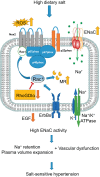Involvement of ENaC in the development of salt-sensitive hypertension
- PMID: 28003189
- PMCID: PMC5582899
- DOI: 10.1152/ajprenal.00427.2016
Involvement of ENaC in the development of salt-sensitive hypertension
Abstract
Salt-sensitive hypertension is associated with renal and vascular dysfunctions, which lead to impaired fluid excretion, increased cardiac output, and total peripheral resistance. It is commonly accepted that increased renal sodium handling and plasma volume expansion are necessary factors for the development of salt-induced hypertension. The epithelial sodium channel (ENaC) is a trimeric ion channel expressed in the distal nephron that plays a critical role in the regulation of sodium reabsorption in both normal and pathological conditions. In this mini-review, we summarize recent studies investigating the role of ENaC in the development of salt-sensitive hypertension. On the basis of experimental data obtained from the Dahl salt-sensitive rats, we and others have demonstrated that abnormal ENaC activation in response to a dietary NaCl load contributes to the development of high blood pressure in this model. The role of different humoral factors, such as the components of the renin-angiotensin-aldosterone system, members of the epidermal growth factors family, arginine vasopressin, and oxidative stress mediating the effects of dietary salt on ENaC are discussed in this review to highlight future research directions and to determine potential molecular targets for drug development.
Copyright © 2017 the American Physiological Society.
Figures

Similar articles
-
Role of Rho GDP dissociation inhibitor α in control of epithelial sodium channel (ENaC)-mediated sodium reabsorption.J Biol Chem. 2014 Oct 10;289(41):28651-9. doi: 10.1074/jbc.M114.558262. Epub 2014 Aug 27. J Biol Chem. 2014. PMID: 25164814 Free PMC article.
-
Epithelial Sodium Channel and Salt-Sensitive Hypertension.Hypertension. 2021 Mar 3;77(3):759-767. doi: 10.1161/HYPERTENSIONAHA.120.14481. Epub 2021 Jan 25. Hypertension. 2021. PMID: 33486988 Free PMC article. Review.
-
Deficiency of renal cortical EGF increases ENaC activity and contributes to salt-sensitive hypertension.J Am Soc Nephrol. 2013 Jun;24(7):1053-62. doi: 10.1681/ASN.2012080839. Epub 2013 Apr 18. J Am Soc Nephrol. 2013. PMID: 23599382 Free PMC article.
-
Caffeine intake antagonizes salt sensitive hypertension through improvement of renal sodium handling.Sci Rep. 2016 May 12;6:25746. doi: 10.1038/srep25746. Sci Rep. 2016. PMID: 27173481 Free PMC article.
-
Direct regulation of ENaC by bradykinin in the distal nephron. Implications for renal sodium handling.Curr Opin Nephrol Hypertens. 2014 Mar;23(2):122-9. doi: 10.1097/01.mnh.0000441053.81339.61. Curr Opin Nephrol Hypertens. 2014. PMID: 24378775 Free PMC article. Review.
Cited by
-
Renal lysophospholipase A1 contributes to Enterococcus faecalis-induced hypertension by enhancing sodium reabsorption.iScience. 2022 Oct 19;25(12):105403. doi: 10.1016/j.isci.2022.105403. eCollection 2022 Dec 22. iScience. 2022. PMID: 36419851 Free PMC article.
-
Reactivity of renal and mesenteric resistance vessels to angiotensin II is mediated by NOXA1/NOX1 and superoxide signaling.Am J Physiol Renal Physiol. 2023 Apr 1;324(4):F335-F352. doi: 10.1152/ajprenal.00236.2022. Epub 2023 Feb 9. Am J Physiol Renal Physiol. 2023. PMID: 36759130 Free PMC article.
-
Bile acids and salt-sensitive hypertension: a role of the gut-liver axis.Am J Physiol Heart Circ Physiol. 2022 Apr 1;322(4):H636-H646. doi: 10.1152/ajpheart.00027.2022. Epub 2022 Mar 4. Am J Physiol Heart Circ Physiol. 2022. PMID: 35245132 Free PMC article. Review.
-
A Novel Mechanism of Renal Microcirculation Regulation: Connecting Tubule-Glomerular Feedback.Curr Hypertens Rep. 2019 Jan 18;21(1):8. doi: 10.1007/s11906-019-0911-5. Curr Hypertens Rep. 2019. PMID: 30659366 Free PMC article. Review.
-
Characterization of Contractile Machinery of Vascular Smooth Muscles in Hypertension.Life (Basel). 2021 Jul 16;11(7):702. doi: 10.3390/life11070702. Life (Basel). 2021. PMID: 34357074 Free PMC article. Review.
References
Publication types
MeSH terms
Substances
Grants and funding
LinkOut - more resources
Full Text Sources
Other Literature Sources
Medical

